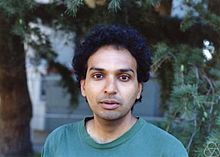Kiran Kedlaya
Kiran Kedlaya | |
|---|---|
 | |
| Born | June 1974 (age 50) United States[2] |
| Alma mater | MIT (Ph.D. 2000) Princeton (M.A. 1997) Harvard (B.A. 1996) |
| Awards | Presidential Early Career Award for Scientists and Engineers (2006)[1] Fellow, American Mathematical Society (2012) |
| Scientific career | |
| Fields | Mathematics |
| Institutions | UCSD MIT |
| Doctoral advisor | Aise Johan de Jong |
| Doctoral students | Jennifer Balakrishnan |
| Website | kskedlaya |
Kiran Sridhara Kedlaya (/ˈkɪrən ˈʃriːdər kɛdˈlɑːjə/ KIRR-ən SHREE-dər ked-LAH-yə;[3] born July 1974) is an American mathematician. He currently is a Professor of Mathematics and the Stefan E. Warschawski Chair in Mathematics[4] at the University of California, San Diego.
Biography
[edit]Kiran Kedlaya was born into a Tulu Brahmin family.[5] At age 16, Kedlaya won a gold medal at the International Mathematics Olympiad,[6] which he later followed with a silver and another gold medal. While an undergraduate student at Harvard, he was a three-time Putnam Fellow in 1993, 1994, and 1995.[7] A 1996 article by The Harvard Crimson described him as "the best college-age student in math in the United States".[8]
Kedlaya was runner-up for the 1995 Morgan Prize, for a paper[9] in which he substantially improved on results of László Babai and Vera Sós (1985)[10] on the size of the largest product-free subset of a finite group of order n.
He gave an invited talk at the International Congress of Mathematicians in 2010, on the topic of "Number Theory".[11]
In 2012 he became a fellow of the American Mathematical Society.[12]
Game shows
[edit]Kedlaya was a contestant on the game show Jeopardy! in 2011, winning one episode.[13]
Selected works
[edit]- p-adic Differential Equations, Cambridge Studies in Advanced Mathematics, Band 125, Cambridge University Press 2010[14]
- with David Savitt, Dinesh Thakur, Matt Baker, Brian Conrad, Samit Dasgupta, Jeremy Teitelbaum p-adic Geometry, Lectures from the 2007 Arizona Winter School, American Mathematical Society 2008
- with Bjorn Poonen, Ravi Vakil The William Lowell Putnam Mathematical Competition 1985-2000: Problems, Solutions and Commentary, Mathematical Association of America, 2002
References
[edit]- ^ "The Presidential Early Career Award for Scientists and Engineers: Recipient Details: Kiran Kedlaya". NSF.
- ^ Kedlaya, Kiran. "About my name".
- ^ "About My Name".
- ^ "Exploring the mathematical universe". American Institute of Mathematics. 10 May 2016. Retrieved 2 August 2017.
- ^ "Kiran S. Kedlaya".
- ^ "Silver Spring whiz kid brings home the gold". Washington Times. July 20, 1990.
- ^ "Putnam Competition Individual and Team Winners". Mathematical Association of America. Retrieved December 14, 2021.
- ^ Hsu, Geoffrey C. (June 6, 1996). "Breaking the Curve". The Harvard Crimson.
- ^ ——— (1997). "Large Product-Free Subsets of Finite Groups". Journal of Combinatorial Theory. Series A. 77 (2): 339–343. doi:10.1006/jcta.1997.2715.
- ^ Babai, László; Sós, Vera T. (1985). "Sidon sets in groups and induced subgraphs of Cayley graphs" (PDF). European Journal of Combinatorics. 6 (2): 101–114. doi:10.1016/s0195-6698(85)80001-9.
- ^ "ICM Plenary and Invited Speakers since 1897". International Congress of Mathematicians. Archived from the original on 2017-11-08. Retrieved 2013-08-15.
- ^ List of Fellows of the American Mathematical Society, retrieved 2013-01-27.
- ^ Jeopardy! Archive – Show #6257, aired 2011–11–29
- ^ Berger, Laurent (2012). "Review: p-adic differential equations, by Kiran Kedlaya" (PDF). Bull. Amer. Math. Soc. (N.S.). 49 (3): 465–468. doi:10.1090/s0273-0979-2012-01371-X.
External links
[edit]- 1974 births
- Living people
- Algebraic geometers
- Indian number theorists
- American people of Indian descent
- People from Silver Spring, Maryland
- Harvard University alumni
- Princeton University alumni
- Massachusetts Institute of Technology School of Science alumni
- Massachusetts Institute of Technology faculty
- University of California, San Diego faculty
- Fellows of the American Mathematical Society
- International Mathematical Olympiad participants
- 21st-century Indian mathematicians
- Putnam Fellows
- Recipients of the Presidential Early Career Award for Scientists and Engineers
- American mathematician stubs
